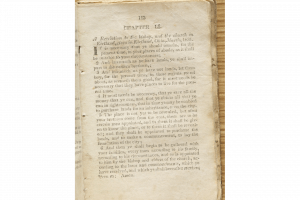Historical Context and Background of D&C 48
Brief Synopsis by Steven C. Harper
The literal gathering of Israel and building of New Jerusalem raise questions. Section 48 was given to answer some of them. Sections 37 and 38 inspired saints in New York to move to Ohio in the fall and winter of 1830–1831. Section 41 called Edward Partridge to be their bishop. Section 42 gave them the law of consecration to live by and gave the bishop responsibility for “the properties of my church” and “the poor and the needy.” It also told Bishop Partridge to obtain places where the New York saints to settle.1
As spring of 1831 arrived in Ohio and saints from New York with it, the bishop became anxious for more specific instructions and answers.2 It is premature, the Lord says, to try to build New Jerusalem yet. Rather, let the New York saints get settled as best they can first. Then the Lord will reveal more about New Jerusalem. Then he will appoint people to lay its foundation. “Then shall ye begin to be gathered with your families” (D&C 48:6).
Section 48 answered Bishop Partridge’s questions and mapped out an orderly, step-by-step process for building and inhabiting New Jerusalem based on previous and future revelation. It also answers common questions related to the law of consecration. Is saving contrary to consecration? What about “obtaining” money? Section 48 clarifies that one’s motives matter very much when it comes to saving and obtaining. It commands the saints, as prophets have since, to save all they can for righteous purposes. It commands them to earn all they can “in righteousness” so they can build Zion. It is a restatement of the Lord’s command to seek his Kingdom first and foremost. Earning and saving for that reason is not only justified. It is commanded.
1. “Revelation, 9 February 1831 [D&C 42:1–72],” p. [1], The Joseph Smith Papers, accessed September 30, 2020.
2. “John Whitmer, History, 1831–circa 1847,” p. 23, The Joseph Smith Papers, accessed July 30, 2020.
Additional Context by Casey Paul Griffiths
From Doctrine and Covenants Minute
In the spring of 1831, the Saints in Kirtland found themselves in the midst of a refugee crisis. More than a hundred Church members from New York were making their way to Kirtland and the surrounding areas as part of the Lord’s commandment to gather to the Ohio (D&C 37). John Whitmer recorded in his history, “The time drew near for the brethren from the State of New York to arrive at Kirtland Ohio. And some had supposed that it was the place of gathering even the place of the New Jerusalem spoken of in the Book of Mormon, according to the visions and revelations received in the last days. There was no preparation made for the reception of the Saints from the East. The Bishop [Edward Partridge] being anxious to know something concerning the matter. Therefore, the Lord spake unto Joseph Smith Jr. as follows.”1
According to John Whitmer’s record, Church leaders faced two challenges. First, some members believed that the Kirtland area was the place for the New Jerusalem. In the revelation, the Lord addresses this misunderstanding by informing the Saints that He had not yet revealed the place for the city (D&C 48:5). Second, Bishop Partridge and others sought guidance on how to utilize the law of consecration, which had been revealed only one month earlier, to assist the Saints from the East who were gathering to Kirtland. In the revelation, the Lord emphasized the importance of flexibility in the implementation of the law, asking the bishop and other Church leaders to consider “every man according to his family, according to his circumstances” (D&C 48:6).
“Historical Introduction,” Revelation, 10 March 1831 [D&C 48]
1. Whitmer, History, 23, JSP.


